 |
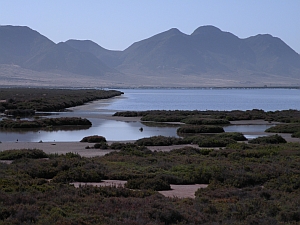 Salinas de Cabo de Gata
© Teresa Farino
Salinas de Cabo de Gata
© Teresa Farino
Cabo de Gata
Cabo de Gata, in the province of Almería, south-eastern Spain, is an arid, volcanic landscape, unique in Europe. It comprises sea-cliffs, volcanic sierras and a coastal plain populated by extensive dunes, stony plateaux, small lagoons and salt-pans. It harbours an important steppe bird community and a diverse avifauna associated with the coastal wetlands, and is also renowned for its rich floral and invertebrate assemblages, including many endemic species.
Introduction
The Parque Natural Marítimo-Terrestre de Cabo de Gata-Níjar, also a Natura 2000 site and Biosphere Reserve, covers almost 50,000 ha to the east of the city of Almería, including the Salinas de Cabo de Gata Ramsar Site (300 ha). In essence, the parque natural comprises four distinct geographical units:
- the off-shore marine habitats;
- around 40km of coastal cliffs (some up to 100m high) and secluded coves in the eastern sector of the park, which represent one of the best-preserved sections of Spain's much-besieged Mediterranean coast;
- the coastal plain of the Bahía de Almería, in the western part of the park, about 500m wide and encompassing important dune systems, xerophytic scrub, ramblas housing small coastal lagoons and salinas;
- the Sierra de Cabo de Gata of the hinterland, a labyrinth of raw, reddish rock, peaking at just 493m (Cerro de los Frailes).
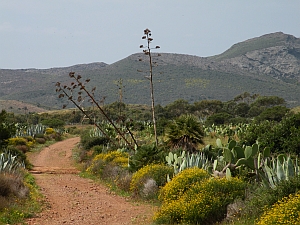 Behind Playa de los Genoveses
© Teresa Farino
Behind Playa de los Genoveses
© Teresa Farino
The overriding geological characteristic of the park is its volcanic origin, as evidenced by ancient calderas, lava flows and pyroclastic rocks, rich in mineral deposits such as gold, silver, lead and zinc, as well as jasper and agate. These were much exploited on a small scale in the past, with the name 'Cabo de Gata' in fact originating from 'Cabo de Agata', rather than referring to a female cat!
This is one of the most arid regions of Europe. The excessively low levels of precipitation - typically between 150-200mm per year - and over 3,000 hours of sunshine annually mean that climatically the region has more in common with North Africa or the Middle East, although humidity is relatively high as a result of its proximity to the sea. Trees are scarce here, but not just as a result of the arid nature of the terrain, since much of the unique climax scrub of Dwarf Fan Palm (Chamaerops humilis), Periploca laevigata ssp. angustifolia, Maytenus senegalensis, Ulex canescens, Genista spartioides and Ziziphus lotus has succumbed to felling, overgrazing and fire in historical times, being replaced today by sparse secondary communities.
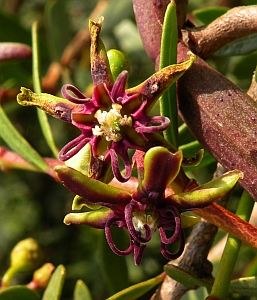 Periploca laevigata ssp. angustifolia
© Teresa Farino
Periploca laevigata ssp. angustifolia
© Teresa Farino
Despite - or perhaps because of - the high temperatures and extremely low levels of precipitation here, Cabo de Gata is home to around 1,000 species of vascular plant, about 75% of which are exclusive to the Mediterranean region, 12% are Afro-Iberian endemics and a further 12% are unique to Iberia. Furthermore, six species are found only in the Cabo de Gata area (see box). Other typical floral elements of the landscape, such as Prickly Pears (Opuntia spp.) and Sisals (Agave fourcroydes and A. sisalana), were introduced for agricultural purposes (the Sisals for making rope and the Prickly Pears as the food-plant of the coccid bug Dactylopius coccus, from which cochineal is obtained).
| Endemic plants of Cabo de Gata |
| Dianthus charidemi |
| Ulex canescens |
| Teucrium charidemi |
| Verbascum charidemi |
| Antirrhinum charidemi |
| Androcymbium gramineum |
Cabo de Gata's coastal waters are some of the least polluted in the western Mediterranean. Within the protected offshore area - which covers 12,000ha of the park and extends down to a depth of around 50m - more than 1,400 species of marine animals and plants have been recorded, the high biodiversity of this stretch of coast due in the main to the convergence of Atlantic and
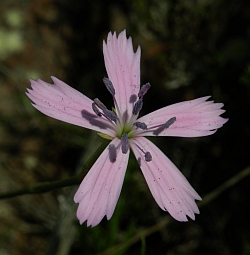 Dianthus charidemi
© Teresa Farino
Mediterranean currents here. Sandy substrata in the Bahía de Almería harbour extensive undersea meadows of Posidonia (Posidonia oceanica), Eelgrass (Zostera marina) and Cymodocea nodosa down to a depth of around 20m, and are also home to the enormous Fan Mussel (Pinna nobilis): the Mediterranean's largest bivalve (up to 80cm long). Rocky habitats to the northeast, by comparison, are carpeted with 'seaweeds' such as the delicate Mermaid's Cup (Acetabularia acetabulum), Calcareous Green Alga (Halimeda tuna) and Udotea petiolata, and inhabited by thousands of Runner Crabs (Pachygrapsus marmoratus).
Dianthus charidemi
© Teresa Farino
Mediterranean currents here. Sandy substrata in the Bahía de Almería harbour extensive undersea meadows of Posidonia (Posidonia oceanica), Eelgrass (Zostera marina) and Cymodocea nodosa down to a depth of around 20m, and are also home to the enormous Fan Mussel (Pinna nobilis): the Mediterranean's largest bivalve (up to 80cm long). Rocky habitats to the northeast, by comparison, are carpeted with 'seaweeds' such as the delicate Mermaid's Cup (Acetabularia acetabulum), Calcareous Green Alga (Halimeda tuna) and Udotea petiolata, and inhabited by thousands of Runner Crabs (Pachygrapsus marmoratus).
The best wildlife habitats
Starting in the western sector of the parque natural, the stony plain surrounding the SEO/Birdlife visitor centre of Las Amoladeras harbours an abundance of the delightful, low-growing lily Androcymbium europaeum, whose clusters of violet-streaked white flowers bloom in mid-winter, as well as the annual sea-lavender Limonium lobatum, with distinctive ice-blue calices and yellowish flowers, Field Gladiolus (Gladiolus italicus), Barbary Nut (
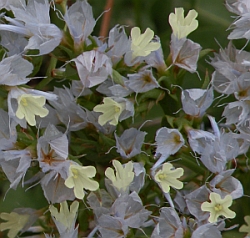 Limonium lobatum
© Teresa Farino
Gynandriris sisyrinchium), Hollow-stemmed Asphodel (Asphodelus fistulosus) and Dipcadi (Dipcadi serotinum).
Limonium lobatum
© Teresa Farino
Gynandriris sisyrinchium), Hollow-stemmed Asphodel (Asphodelus fistulosus) and Dipcadi (Dipcadi serotinum).
South from the visitor centre lie swathes of ancient dunes, access to which is restricted nowadays to protect this fragile ecosystem. Nevertheless, along the few way-marked tracks that exist you can revel in a riot of colourful spring flowers, the most notable contributors being Mallow-leaved Bindweed (Convolvulus althaeoides), Fagonia (Fagonia cretica), the incredibly florid Ononis ramosissima and the lemon-yellow-flowered composite Andryala ragusina.
Away from the path, the dominant botanical elements are the spiny scrub of Ziziphus lotus, clumps of Albardine (Lygeum spartum) and False Esparto (Stipa tenacissima) and a bewildering array of shrubby, succulent chenopods -
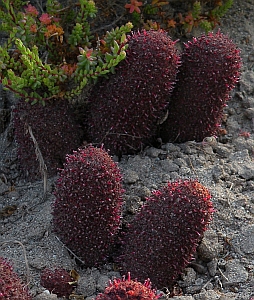 Cynomorium Cynomorium coccineum
© Teresa Farino
Salsola vermiculata, S. longifolia and S. genistoides, the latter endemic to southeast Spain - among which you should turn up the superficially similar Lycium intricatum, distinguished by its narrow-tubed purple flowers. One of the most interesting plants of Cabo de Gata is also to be found here, however, is undoubtedly the frankly phallic Cynomorium (Cynomorium coccineum), which is parasitic on members of the Chenopodiaceae.
Cynomorium Cynomorium coccineum
© Teresa Farino
Salsola vermiculata, S. longifolia and S. genistoides, the latter endemic to southeast Spain - among which you should turn up the superficially similar Lycium intricatum, distinguished by its narrow-tubed purple flowers. One of the most interesting plants of Cabo de Gata is also to be found here, however, is undoubtedly the frankly phallic Cynomorium (Cynomorium coccineum), which is parasitic on members of the Chenopodiaceae.
The most typical birds of this habitat are those that benefit from perching atop the tall Sisal inflorescences to spy out their prey, particularly Little Owl, Bee-eater, Hoopoe Black-eared Wheatear and Woodchat and Southern Grey Shrikes, while the dense scrub is home to Sardinian, Dartford and Spectacled Warblers. Open, sandy areas teem with Thekla and Lesser Short-toed Larks, while Pallid Swifts and Red-rumped Swallows scythe through the air overhead. Spiny-footed Lizards bask along the sides of the path, scuttling into the fringing vegetation as you approach, and you might also encounter Iberian Hares and the greyish southern Iberian subspecies - nevadensis - of Ocellated Lizard. Look out too for the tiny but very lovely Common Tiger Blue butterfly; the larvae feed on Ziziphus lotus, and the adults are often seen flying round the bushes and perched on the spiny, zigzagged stems.
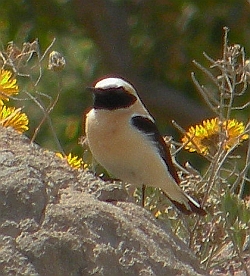 Black-eared Wheatear Oenanthe hispanica
© Teresa Farino
Black-eared Wheatear Oenanthe hispanica
© Teresa Farino
To the northwest of Las Amoladeras lies an abandoned Sisal plantation (dating from 1957), traversed by a road leading to a small radar tower for the nearby airport, set on a hill overlooking a vast stony plateau to the north. This is renowned as being one of the best places for Dupont's Lark at Cabo de Gata (more than 130 pairs are said to nest in the park), as well as housing one of the highest breeding densities of Lesser Short-toed and Thekla Larks in Spain. These steppes are also the haunt
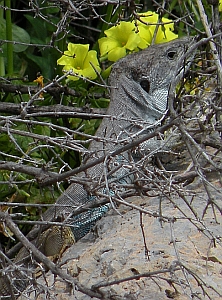 Male Ocellated Lizard Male Ocellated Lizard
Timon lepidus nevadensis© Teresa Farino
of Stone Curlew, Black-bellied Sandgrouse and Short-toed Lark, plus an occasional Trumpeter Finch or Little Bustard, with Richard's Pipit purportedly a habitual winter visitor. The outstanding plant here is probably the succulent, yellow-flowered Haplophyllum rosmarinifolium, an Afro-Iberian endemic member of the Rutaceae, but look out too for the succulent, white-flowered Aizoon hispanicum and spiny rosettes of Eryngium ilicifolium in stony areas.
Further east lies the seasonal watercourse known as the Rambla de Morales. A small lagoon here attracts all manner of waterbirds on migration, with regular visitors including Squacco Heron, White-headed Duck, Garganey,
Marsh Harrier, Spotted Redshank, Collared Pratincole, Slender-billed, Audouin's and Mediterranean Gulls and Gull-billed Tern, among more commonplace species such as Little Egret, Black-winged Stilt, Avocet, Kentish and Ringed
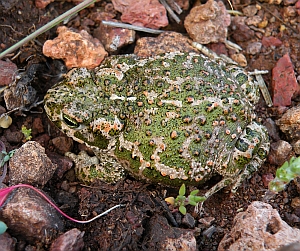 Natterjack Toad Bufo calamita
© Teresa Farino
Plovers, Sanderling, Curlew Sandpiper, Little Stint, Black-tailed and Bar-tailed Godwits, Sandwich and Whiskered Terns, Sand Martin and Yellow Wagtail.
Natterjack Toad Bufo calamita
© Teresa Farino
Plovers, Sanderling, Curlew Sandpiper, Little Stint, Black-tailed and Bar-tailed Godwits, Sandwich and Whiskered Terns, Sand Martin and Yellow Wagtail.
The marshy edges of the lagoon are the haunt of damselflies and dragonflies such as Iberian Bluetail, Black-tailed Skimmer, Red-veined and Southern Darters and Violet Dropwing, the latter found only in southern Europa and North Africa. Natterjack Toads can also be found here, with hundreds, if not thousands of newly metamorphosed individuals emerging after spring rains.
The coastal dunes surrounding the lagoon are clothed with a succession (from the shore inland) of Sea Medick (Medicago marina), Southern Birdsfoot-trefoil (Lotus creticus), Coastal Crucianella (Crucianella maritima), Cottonweed (Otanthus maritimus), the sea heath Frankenia corymbosa, Winged Sea-lavender (Limonium sinuatum), with its distinctive undulate leaves, Thymelaea hirsuta, Helichrysum stoechas, Cyperus capitatus
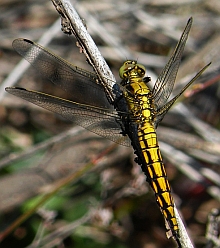 Female Black-tailed Skimmer
Female Black-tailed Skimmer
Orthetrum cancellatum
© Teresa Farino
and the silvery stems of Atriplex glauca. Succulent, purple-tinged carpets of Mesembryanthemum nodiflorum are decorated at intervals with small white flowers, while Ice Plant (M. crystallinum) is distinguished by the shiny, sticky secretions that decorate the foliage. Look out too for 'pincushions' of the distinctive grass Ammochloa palaestina in the oldest dunes.
Spiny-footed Lizards, Large Psammodromuses and quicksilver Bedriaga's Skinks are very much at home here, as are Kentish Plover and Short-toed Larks in summer, while one of the more distinctive grasshoppers of these dunes is the 'long-nosed' Pyrgomorpha conica, present here in both its green and greyish forms. Translucent amber scorpions Buthus occitanus can be found by turning over the rocks that provide their daytime refuge.
Heading east, once past the village of Cabo de Gata itself, you soon reach the Ramsar salinas, just to the north of the coast road. Entry is forbidden,
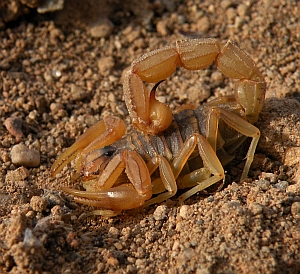 Buthus occitanus
© Teresa Farino
but you can walk around the edge and several small hides along the southern margin will furnish you with excellent views of Greater Flamingo, present in small numbers during much of the year, with late summer concentrations often exceeding 2,000 individuals (various breeding attempts have been noted in recent years). Habitually more successful are nesting Avocet (193 pairs), Kentish Plover (35 pairs), Little Tern (35 pairs) and a few pairs of Common Tern, as well as Cetti's, Reed and Great Reed Warblers in the peripheral reedbeds. In winter look out for Shelduck, Wigeon, Shoveler, Osprey and even Caspian Tern, while spring usually turns up most of the waders, terns and gulls mentioned for the Rambla de Morales, with Audouin's Gull present all year round, despite not breeding here.
Buthus occitanus
© Teresa Farino
but you can walk around the edge and several small hides along the southern margin will furnish you with excellent views of Greater Flamingo, present in small numbers during much of the year, with late summer concentrations often exceeding 2,000 individuals (various breeding attempts have been noted in recent years). Habitually more successful are nesting Avocet (193 pairs), Kentish Plover (35 pairs), Little Tern (35 pairs) and a few pairs of Common Tern, as well as Cetti's, Reed and Great Reed Warblers in the peripheral reedbeds. In winter look out for Shelduck, Wigeon, Shoveler, Osprey and even Caspian Tern, while spring usually turns up most of the waders, terns and gulls mentioned for the Rambla de Morales, with Audouin's Gull present all year round, despite not breeding here.
In total, more than 100 species of bird habitually use these shallow salt-pans at various times of year, with the highest diversity occurring during the autumn migration. Some of the more interesting passage records include Black Stork, Purple Heron, White-headed Duck, Red-crested Pochard, Red-breasted Merganser and Slender-billed Gull. In addition, Montagu's Harriers and Red-necked Nightjars breed in the scrubby steppes to the north of the salinas.
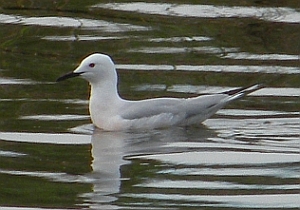 Slender-billed Gull Larus genei
© Teresa Farino
Slender-billed Gull Larus genei
© Teresa Farino
The halophytic flora of these working salinas (which produce some 30,000 tonnes of salt each year) is dominated by a multitude of succulent chenopods - Purple and Common Glassworts (Salicornia ramosissima & Sarcocornia fruticosa), Annual and Shrubby Sea-blites (Suaeda maritima & S. vera), Suaeda splendens, Sea-purslane (Halimione portulacoides), Atriplex glauca and Arthrocnemum macrostachyum - plus the Spanish endemic sea-lavender Limonium cossonianum. Here too you can find the grasses Aeluropus littoralis, Crypsis aculeata, Cutandia memphitica and Sporobolus pungens, as well as fringing stands of Giant and Common Reeds ((Arundo donax & Phragmites australis), Sharp and Sea Rushes (Juncus acutus & J. maritimus), Golden-samphire (Inula crithmoides)and the Afro-Iberian endemic tamarisk Tamarix boveana. Much the same dune species as at Rambla Morales occur in the surrounding sand-flats, with the notable addition of some spectacular clumps of fluorescent pink Silene littorea and flower-studded cushions of Yellow Sea aster (Asteriscus maritimus).
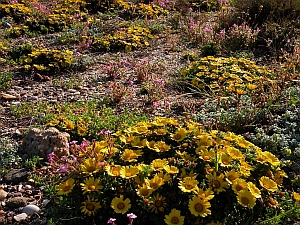 Yellow Sea Aster Asteriscus maritimus
© Teresa Farino
Yellow Sea Aster Asteriscus maritimus
© Teresa Farino
From here it is only a short distance to the lighthouse, where the road ahead is closed to vehicles, but you can continue on foot up to the Vela Blanca watchtower and from there down towards San José, on a track that traverses a stretch of impressive volcanic cliffs. This is where the majority of Cabo de Gata's most interesting plants are to be found, including untidy clumps of the pink-flowered Antirrhinum charidemi - perhaps the most emblematic of the park's endemics - clinging to the sheer reddish rock faces, the very woolly endemic germander Teucrium charidemi growing by the sides of the trail, and an abundance of Ulex canescens.
Along the margins of the path grow Yellow Horned-poppy (Glaucium flavum), Sea Mallow (Lavatera maritima) and the bushy, pink-flowered sea-lavender Limonium insigne, together with a multitude of aromatic Mediterranean shrubs: Fringed Rue (Ruta chalepensis), Thymus vulgaris, T. hyemalis, Cut-leaved, Toothed and French Lavenders (Lavandula multifida, L. dentata & L. stoechas), Phlomis purpurea and the stunning yellow-flowered P. lychnitis. This is also as good a place as any to search for one of the more curious plants of Cabo de Gata: the cactus-like Caralluma europaea, a square-stemmed, succulent member of the Asclepiadaceae whose star-shaped purple-striped yellow flowers appear between March and June.
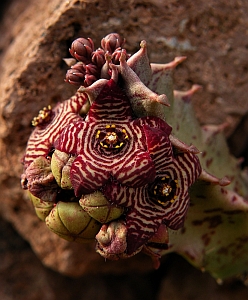 Caralluma europaea
© Teresa Farino
Caralluma europaea
© Teresa Farino
Typical cliff-breeding birds here are Peregrine, Black Wheatear, Blue Rock Thrush and Jackdaw, while scrubby habitats host Sardinian and Spectacled Warblers. Offshore, Gannets and Audouin's Gulls float by at regular intervals, while scattered colonies of Storm Petrel occur along the more remote cliff-lined coast to the north-east, possibly accompanied by small numbers of Shag. The area around the lighthouse regularly turns up Rock Sparrow and Trumpeter Finch, but although around 50 pairs of these distinctive orange-billed finches breed in the park, they are notoriously hard to track down. Of interest among the spring butterflies are Sage Skipper, Green-striped White, Black-eyed Blue, Spanish Marbled White and Spanish Gatekeeper.
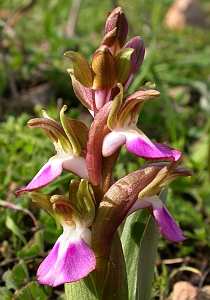 Fan-lipped Orchid Orchis collina
© Teresa Farino
Fan-lipped Orchid Orchis collina
© Teresa Farino
An interesting excursion in the heart of the volcanic sierra de Cabo de Gata leads you from the hamlet of Las Presillas Bajas north and east to the caldera of Majada Redonda. The first part of the trail follows the sandy bed of a stream that flows only immediately after torrential rain: the Spanish equivalent of a wadi. A rather different assemblage of plants clothes the sides of this gully and surrounding cultivated plots, with Red Horned-poppy (Glaucium corniculatum), the purple-flowered stock Matthiola lunata, Grey-leaved Cistus (Cistus albidus), Anthyllis cytisoides, Bladder-vetch (Tripodion tetraphyllum), Spanish Vetchling (Lathyrus clymenum), the enormous yellow-flowered umbellifer Ferula tingitana (an Afro-Iberian endemic), Ground-pine Germander (Teucrium pseudochamaepitys), Large Blue Alkanet (Anchusa azurea), Fan-lipped Orchid (Orchis collina) and Mirror Ophrys (Ophrys speculum), among the more noteworthy representatives.
Lataste's Viper is one reptile to watch out for here, although you're more likely to come across Moorish Geckos, Large and Spanish Psammodromuses and Ladder and Montpellier Snakes. Bonelli's Eagles are sometimes seen floating above the crater; a pair is still
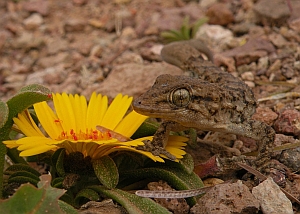 Moorish Gecko Tarentola mauritanica
© Teresa Farino
thought to breed in these interior ranges, together with about 20 pairs of Eagle Owl. Closer at hand you might come across Red-legged Partridge, Alpine Swift, Crag Martin, Thekla Lark, Black Redstart, Black and Black-eared Wheatears, Blue Rock Thrush, Woodchat Shrike and scores of Corn Buntings, while Algerian hedgehogs - distinguished from Western Hedgehogs by their longer legs and spine-free 'parting' on the crown of the head - are known to occur in the more densely vegetated areas, although they rarely venture out during the day.
Moorish Gecko Tarentola mauritanica
© Teresa Farino
thought to breed in these interior ranges, together with about 20 pairs of Eagle Owl. Closer at hand you might come across Red-legged Partridge, Alpine Swift, Crag Martin, Thekla Lark, Black Redstart, Black and Black-eared Wheatears, Blue Rock Thrush, Woodchat Shrike and scores of Corn Buntings, while Algerian hedgehogs - distinguished from Western Hedgehogs by their longer legs and spine-free 'parting' on the crown of the head - are known to occur in the more densely vegetated areas, although they rarely venture out during the day.
Spring butterflies include Bath, Western Dappled and Green-striped Whites, Small Copper, Lang's Short-tailed Blue and Spanish Marbled White, accompanied by Goldwing moths (Synthymia fixa), White-collared Burnet Moths (Zygaena lavandulae) and the more colourful Zygaena fausta. You might also encounter some of the weird and wonderful grasshoppers and crickets of the area, such as Truxalis nasuta, Eumigus cucullatus almeriensis, Pycnogaster sanchezgomezi and Odontura aspericauda, or one of the corpulent Striped or Royal Oil Beetles (Berberomeloë majalis & B. insignis), the latter species endemic to south-eastern Spain.
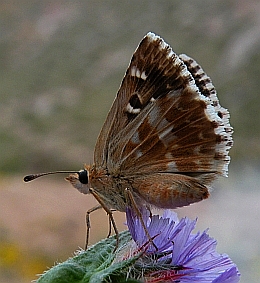 Sage Skipper Syrichtus proto
© Teresa Farino
Sage Skipper Syrichtus proto
© Teresa Farino
Related information:
Spring Wildlife Tour of Almería
Read about Teresa Farino
Wildlife holidays in Spain & Portugal
|